022 - Preventing Deer Damage to Your Trees and Shrubs
Deer/human conflicts have increased due to growing deer populations, limited resources and suburban development in deer habitat. In winter, deer often browse in residential landscapes. This can be reduced by selecting unpalatable plants, protecting woody plants with burlap or trunk protectors, and using deer repellent. In extreme cases, deer can be completely excluded with a fence.
Introduction
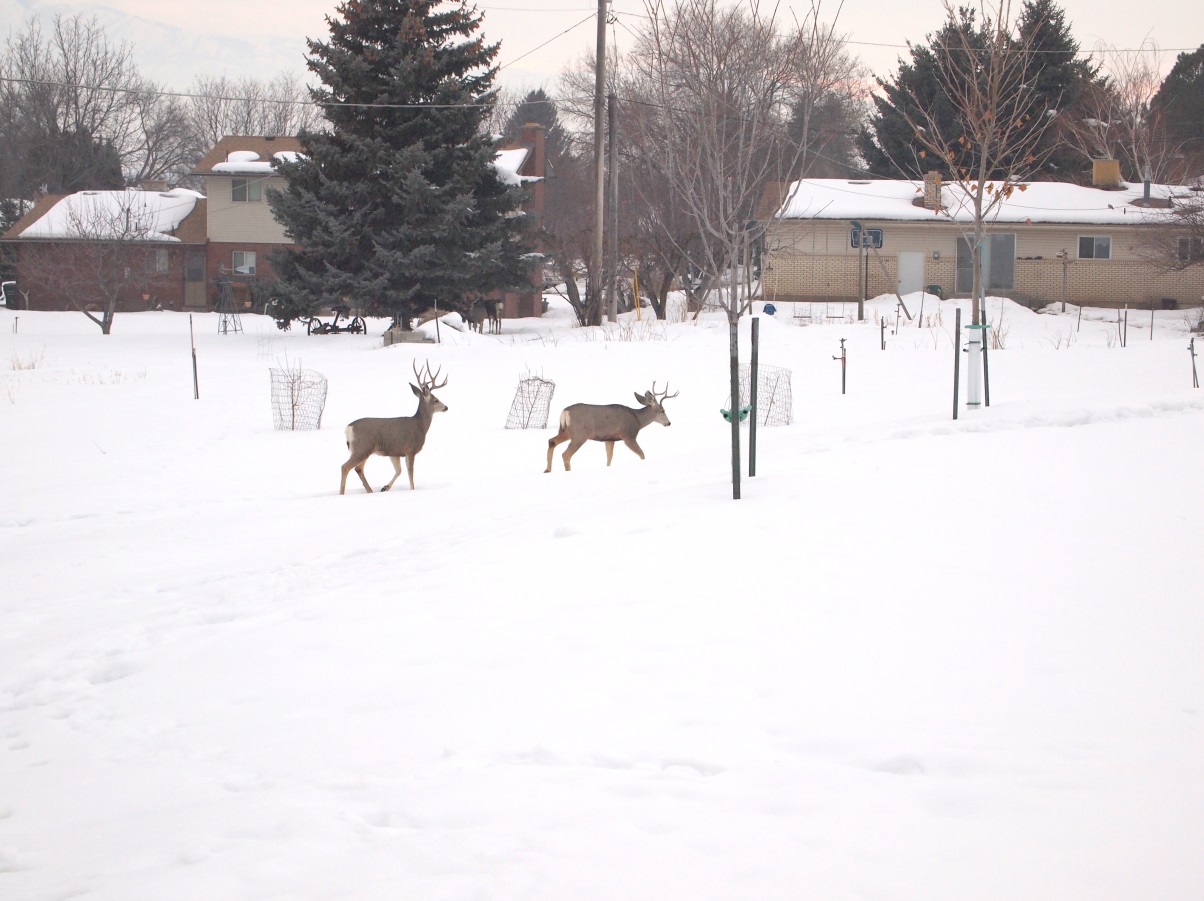
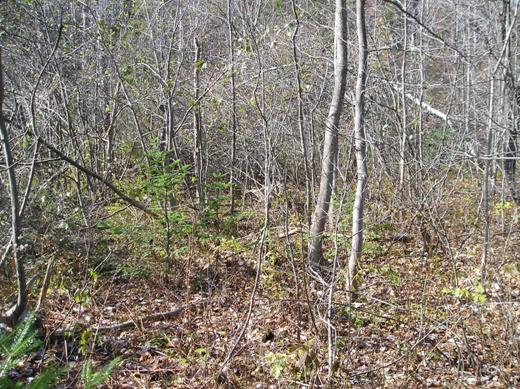
Mule deer habitat example
Mule deer (Odocoileus hemionus) are the most abundant big game animal in Utah and are found throughout the state. Mule deer have specific forage requirements and are selective in their feeding behavior. In the wild, they rely heavily on shrubs like willows and dogwoods that grow in sunny, disturbed areas. The feeding they do on these woody materials is called browsing and the plants are sometimes called browse. Natural browse may be less available than in the past because much of the traditional mule deer winter range along the Wasatch Front and elsewhere has been replaced by pavement, homes and cultivated landscapes.
Mule deer spend summers in the mountains and, when food is scarce in late November, move to the foothills that border the valleys where most of us live. Sometimes the plants available for deer to browse in these areas are not adequate to satisfy the nutritional requirements for wintering mule deer. When natural winter browse is limited, the consequences for mule deer survival and fertility can be serious. Therefore deer may heavily browse ornamental shrubs and trees in winter, causing conflicts between mule deer and residents.
Deer damage may also occur in the summer, particularly during droughts when some native plants are water stressed and become toxic. In such cases, continuous protection may be needed to avoid yearround damage.
Utah DWR and Mule Deer Damage
The Utah Division of Wildlife Resources (UDWR) is aware of Utah’s urban deer problem and is currently evaluating ways to manage these populations. Utah Division of Wildlife Resources biologist Darren DeBloois assures us that deterring mule deer from browsing on shrubs and trees in our yards likely will not cause them to starve over the winter. They will find other foraging opportunities.
Solutions
To reduce mule deer damage to landscape trees and shrubs, you need to physically exclude them from individual plants or entire landscapes, use unpalatable plants in your yard or garden, or temporarily protect plants with deer repellents.
Fencing

Fences provide the most reliable method for controlling deer damage. To be effective, 10 foot tall fencing should be installed around sensitive areas. Positioning a fence outside the canopy edge of low-branching hardwoods or just beyond the bottom branches of conifers will prevent most damage. A common use for fencing would be for protecting an entire orchard. Fencing should also be tight to the ground so that deer cannot crawl underneath.
Pros
- Fences ensure that mule deer cannot browse on enclosed plants.
- Fencing can protect plants from deer damage for many years, assuming gates are closed and fences are maintained.
Cons
- Construction and maintenance costs may be prohibitive.
- Fencing may not be aesthetically pleasing to you or your neighbors.
Tree Protectors
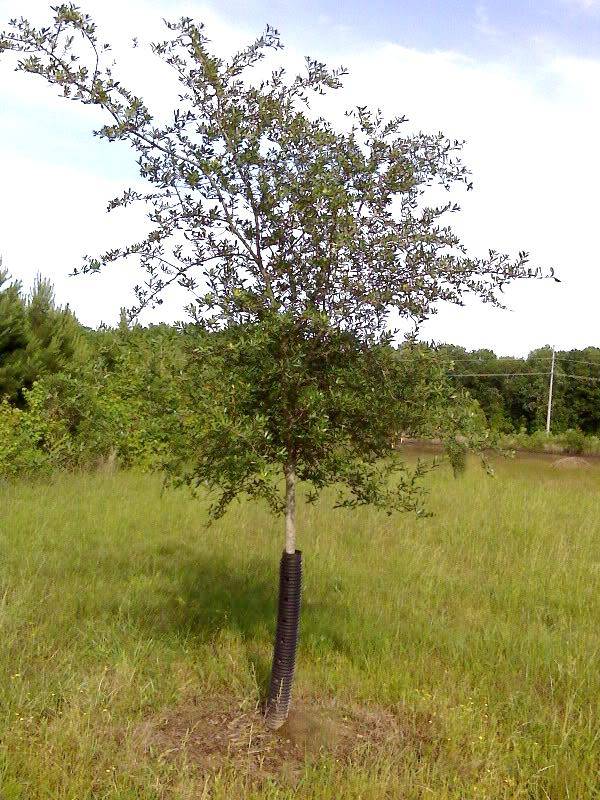
Homemade drainpipe tree protector
In the fall, male deer often rub their antlers against trees to remove the velvet layer that coats them. This rubbing can cause large scars on trunks and branches and can cause permanent damage. You can use tree protectors to guard trees in your yard from such damage. There are many kinds of tree protectors. They are made of polypropylene tubing, woven-wire mesh cylinders or other materials. You can even make your own by cutting a plastic drainpipe down one side and sliding it over the trunk.
Pros
- Tree protectors are affordable and effective at inhibiting deer damage to tree bark.
- Tree protectors may be left on year-round, providing that they allow for normal tree development.
Cons
- Tree protectors may not be aesthetically appealing.
- With small trees, the deer may just push over the entire protector and tree.
- Trees may be so small that their foliage is contained in the protector and the foliage and stem may not develop normally.
Shrub Protectors
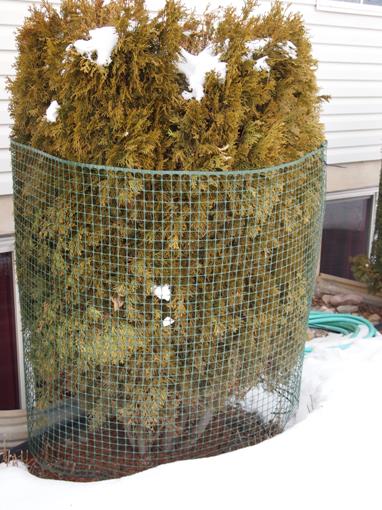
Shrub protector
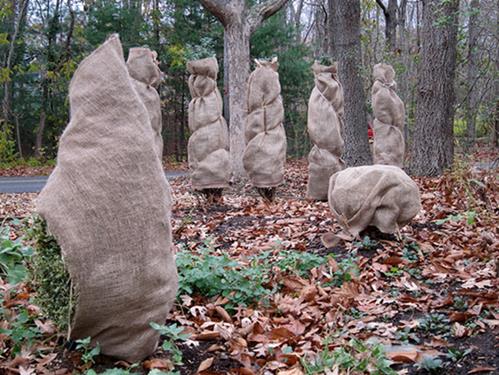
Shrubs protected by burlap
If browsing deer are causing damage to shrubs in your yard, you can wrap individual shrubs with burlap, layered plastic or inexpensive snow fencing.
Pros
- Shrub wrapping is an affordable, quick and effective way to prevent deer damage to individual shrubs.
Cons
- If you have many shrubs to protect, this may be a time consuming and labor intensive task.
- You must unwrap shrubs at the end of the winter to allow for healthy plant production.
- Again, aesthetics may be a problem.
Plant Native and Unpalatable Species
It is possible to discourage deer browsing in your yard by selecting native woody plants and shrubs or other plants that are unpalatable to deer (see list on page 5). You can arrange a “fronting border” of unpalatable plants around the perimeter of your yard to discourage deer from entering the property. Some effective fronting border plants are: cleome, zinnias, firs, hemlocks, pines, spruces and junipers.
Pros
- Native plants that are unpalatable to deer may use fewer resources like water and fertilizer and require less maintenance because they are specifically suited for the local conditions.
- Native species provide habitat and food for other wildlife and birds.
Cons
- Switching out non-native plants for native, unpalatable plants in your yard can be time consuming and costly.
- Planting native and unpalatable species may limit your plant selection options when planning your yard or garden.
- Sometimes native plants are not readily available.
Starting Plants From Seed: An Affordable and Easy Way to Propagate Plants
- Gather seeds from native species that are unpalatable to deer. There is a list found later in this article.
- Scarify seeds. Scarification means removing or breaking through the hard outer coat of a seed to promote germination. This process can occur naturally in animals’ stomachs and bird gizzards, but may be sped up with human intervention:
- File seed coats with a metal file. You also may crack them gently with a knife or hammer. -or-
- Soak seeds in boiling water and remove them when water cools to room temperature.
- Scarify seeds. Scarification means removing or breaking through the hard outer coat of a seed to promote germination. This process can occur naturally in animals’ stomachs and bird gizzards, but may be sped up with human intervention:
- Mix scarified seeds with an equal volume of a moist medium (i.e. sand, peat moss). Store in a closed container in a refrigerator; check often to ensure the medium is moist. The time required for this step will vary with species, more info can be found in the USDA Forest Service’s Nursery Manual for Native Plants: A Guide for Tribal Nurseries, which can be found online.
- Sow seeds under favorable conditions (i.e. after danger of frost has passed) and keep moist until well established. Cover the seeds with soil to a depth at least equal to the size of the seed.
Repellents
Some repellents have been shown to be effective deer deterrents. However, you must apply repellents in above-freezing temperatures and reapply every four to five weeks or after precipitation. The most effective repellents contain eggs, preferably putrid eggs. This is found in the brands Deer-Away Big Game Repellent, BGR Spray, BGR mix, Deer-Off, and Deer Stopper II* (*mention of a specific brand of deer repellent is for informational purposes only and does not constitute an endorsement by USU Extension). You also may make your own (see below).
Pros
- Deer will often avoid plants sprayed with repellents containing putrescent egg solids for up to six weeks.
- When applied every four to five weeks, repellents can be a suitable alternative to other mitigation techniques.
Cons
- The cost of deer repellents may be prohibitive if you have a large area to protect.
- Reapplication can be time-consuming.
Homemade Deer Repellent
- 1 egg*
- 1 quart warm water
Combine egg and water in blender, blend, and strain with cheesecloth or nylon (this will prevent the mixture from clogging spray bottle). Place mixture in spray bottle and apply to foliage. Reapply when new growth appears or after precipitation.
*Possible additions to try per 1 quart bottle:
- 1 tsp. hot pepper oil, 1 Tbl. Tabasco sauce, ¼ c milk, 1 tsp. cooking oil, or a few drops of dish soap.
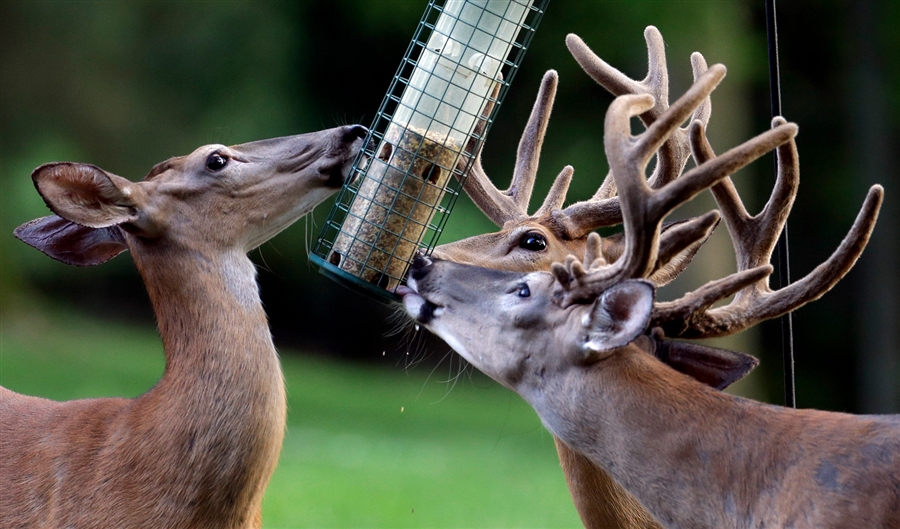
Has Your Birdfeeder Become an Unintended Deer Lure?
Consider these tips when maintaining your birdfeeder at home:
- Place feeders at least 6 feet off the ground or snow surface.
- Use feeders that are not easily penetrated by deer; i.e. tube feeders, hopper feeders or cagestyle suet feeders.
- Secure fencing around the feeder to prevent deer from eating spilled birdseed.
- Avoid using cracked corn, black oil sunflower seeds or seed mixes that attract deer to feeders. Instead choose thistle seed, suet or hummingbird nectar.
Native and Unpalatable Plants List
| Plant Type | Deer Palatability | Scientific Name | Common Name |
|---|---|---|---|
| Shrub | Low | Abelia grandiflora | abelia, glossy |
| Shrub | Low | Fallugia paradoxa | Apache plume |
| Shrub | Low | Fraxinus anomala | ash, singleleaf |
| Shrub | Low | Nandina domestica | bamboo, sacred |
| Shrub | Low | Berberis (Mahonia) spp. | barberry |
| Shrub | Low | Leucophyllum spp. | barometerbush |
| Shrub | Low | Justicia californica | beloperone |
| Shrub | Low | Buxus spp. | boxwood |
| Shrub | Low | Encelia farinosa | brittlebush |
| Shrub | Low | Eriogonum spp. | buckwheat |
| Shrub | Low | Buddelja spp. | butterflybush |
| Shrub | Low | Potentilla spp. | cinquefoil |
| Shrub | Low | Potentilla fruticosa | cinquefoil, shrubby |
| Shrub | Low | Potentilla glandulosa | cinquefoil, sticky |
| Shrub | Low | Potentilla arguta | cinquefoil, tall |
| Shrub | Low | Cordia parvifolia | cordia, littleleaf |
| Shrub | Low | Daphne spp. | daphne |
| Shrub | Low | Cornus sericea | dogwood, red osier |
| Shrub | Low | Calliandra spp. | fairy duster |
| Shrub | Low | Ribes grossularia | gooseberry |
| Shrub | Low | Ilex spp. | holly |
| Shrub | Low | Ilex aquifolium | holly, English |
| Shrub | Low | Agastache urticifolia | hyssop, nettleleaf giant |
| Shrub | Low | Simmondsia chinensis | jojoba |
| Shrub | Low | Lantana spp. | lantana |
| Shrub | Low | Lavandula spp. | lavender |
| Shrub | Low | Arctostaphylos spp. | manzanita |
| Shrub | Low | Arctostaphylos patula | manzanita, greenleaf |
| Shrub | Low | Arctostaphylos pungens | manzanita, pointleaf |
| Shrub | Low | Chrysothamnus viscidiflorus | rabbitbrush, yellow |
| Shrub | Low | Kerria japonica | rose, Japanese |
| Shrub | Low | Rosmarinus officinalis | rosemary |
| Shrub | Low | Salvia spp. | sage |
| Shrub | Low | Caryopteris x clandonensis | spiraea, blue mist |
| Shrub | Low | Rhus spp. | sumac |
| Shrub | Low | Ericameria laricifolia | turpentine bush |
| Shrub | Low | Yucca spp. | yucca |
| Shrub | Low | Yucca baccata | yucca, banana |
| Shrub | Low | Yucca elata | yucca, soaptree |
| Shrub | Med | Prunus armeniaca | apricot |
| Shrub | Med | Vaccinium caespitosum | bilberry, dwarf |
| Shrub | Med | Rubus spp. | blackberry / raspberry |
| Shrub | Med | Symphoricarpos orbiculatus | coralberry |
| Shrub | Med | Cotoneaster apiculatus | cotoneaster, cranberry |
| Shrub | Med | Cotoneaster acutifolius | cotoneaster, Peking |
| Shrub | Med | Cotoneaster horizontalis | cotoneaster, rock |
| Shrub | Med | Ribes spp. | currant |
| Shrub | Med | Ribes aureum | currant, golden |
| Shrub | Med | Sambucus nigra ssp. cerulea | elderberry, blue |
| Shrub | Med | Lonicera utahensis | honeysuckle, Utah |
| Shrub | Med | Kalmia microphylla | laurel, alpine |
| Shrub | Med | Syringa spp. | lilac |
| Shrub | Med | Caragana arborescens | peashrub, Siberian |
| Shrub | Med | Phlox subulata | phlox, moss |
| Shrub | Med | Phlox diffusa | phlox, spreading |
| Shrub | Med | Ligustrum spp. | privet |
| Shrub | Med | Rosa nutkana | rose, Nootka |
| Shrub | Med | Rhus glabra | smooth sumac |
| Shrub | Med | Viburnum opulus | snowball bush |
| Shrub | Med | Symphoricarpos oreophilus | snowberry, mountain |
| Shrub | Med | Spiraea x vanhoutte | spirea, bridalwreath |
| Shrub | Med | Vaccinium scoparium | whortleberry, grouse |
| Shrub | Med | Salix discolor | willow, pussy |
| Shrub | High | Prunus fasciculata | almond, desert |
| Shrub | High | Berberis thunbergi | barberry, Japanese |
| Shrub | High | Cotoneaster dammeri | cotoneaster, bearberry |
| Shrub | High | Frasera spp. | elkweed |
| Shrub | High | Euonymus spp. | euonymus |
| Shrub | High | Pyracantha spp. | firethorn |
| Shrub | High | Forsythia spp. | forsythia |
| Shrub | High | Laurus spp. | laurel |
| Shrub | High | Pinus mugo | pine, mugo |
| Shrub | High | Antennaria dimorpha | pussytoes, low |
| Shrub | High | Antennaria luzuloides | pussytoes, rush |
| Shrub | High | Chaenameles japonica | quince, Maule’s |
| Shrub | High | Rubus idaeus | raspberry, American red |
| Shrub | High | Rosa spp. (cultivated) | rose |
| Shrub | High | Prunus pumila | sandcherry |
| Shrub | High | Viburnum spp. | viburnum |
| Shrub | High | Taxus baccata | yew, English |
| Shrub | High | Taxus cuspidata | yew, Japanese |
| Tree | Low | Fraxinus spp. | ash |
| Tree | Low | Fraxinus americana | ash, white |
| Tree | Low | Betula spp. | birch |
| Tree | Low | Cedrus spp. | cedar |
| Tree | Low | Populus fremontii | cottonwood, Fremont’s |
| Tree | Low | Populus angustifolia | cottonwood, narrowleaf |
| Tree | Low | Pseudotsuga menziesii | Douglas-fir |
| Tree | Low | Abies spp. | fir |
| Tree | Low | Ginkgo biloba | ginkgo |
| Tree | Low | Celtis spp. | hackberry |
| Tree | Low | Crataegus spp. | hawthorn |
| Tree | Low | Yucca brevifolia var. brevifolia | Joshua-tree |
| Tree | Low | Juniperus communis | juniper, common |
| Tree | Low | Juniperus monosperma | juniper, one-seed |
| Tree | Low | Juniperus osteosperma | juniper, Utah |
| Tree | Low | Sophora secundiflora | laurel, Texas mountain |
| Tree | Low | Acer platanoides | maple, Norway |
| Tree | Low | Acer saccharinum | maple, silver |
| Tree | Low | Acer circinatum | maple, vine |
| Tree | Low | Cercocarpus montanus | mountain-mahogany |
| Tree | Low | Quercus spp. | oak |
| Tree | Low | Pinus spp. | pine |
| Tree | Low | Pinus aristata/longaeva | pine, bristlecone |
| Tree | Low | Pinus thunbergii | pine, Japanese black |
| Tree | Low | Pinus flexilis | pine, limber |
| Tree | Low | Pinus contorta | pine, lodgepole |
| Tree | Low | Pinus edulis | pine, pinyon |
| Tree | Low | Pinus ponderosa | pine, ponderosa |
| Tree | Low | Pinus monophylla | pinyon, singleleaf |
| Tree | Low | Cercis spp. | redbud |
| Tree | Low | Artemisia spp. | sagebrush |
| Tree | Low | Picea spp. | spruce |
| Tree | Low | Picea pungens | spruce, blue |
| Tree | Low | Picea engelmanni | spruce, Engelmann |
| Tree | Med | Alnus incana ssp. tenufolia | alder, thinleaf |
| Tree | Med | Prunus amygdalus | almond, flowering |
| Tree | Med | Fraxinus velutina | ash, velvet |
| Tree | Med | Betula occidentalis | birch, water |
| Tree | Med | Acer negundo | boxelder |
| Tree | Med | Catalpa spp. | catalpa |
| Tree | Med | Cupressus arizonica | cypress, Arizona |
| Tree | Med | Abies lasiocarpa | fir, subalpine |
| Tree | Med | Abies concolor | fir, white |
| Tree | Med | Gleditsia triacanthos | honeylocust |
| Tree | Med | Lonicera spp. | honeysuckle |
| Tree | Med | Robinia pseudoacacia | locust, black |
| Tree | Med | Magnolia spp. | magnolia |
| Tree | Med | Acer grandidentatum | maple, bigtooth |
| Tree | Med | Acer palmatum | maple, Japanese |
| Tree | Med | Acer glabrum | maple, Rocky Mountain |
| Tree | Med | Philadelphus inodorus | mock orange, scentless |
| Tree | Med | Physocarpus monogynus | ninebark |
| Tree | Med | Prunus persica | peach |
| Tree | Med | Pyrus spp. | pear |
| Tree | Med | Prunus spp. | plum |
| Tree | Med | Prunus americana | plum, wild |
| Tree | Med | Populus nigra | poplar, Lombardy |
| Tree | Med | Elaeagnus angustifolia | Russian-olive |
| Tree | Med | Salix spp. | willow |
| Tree | High | Malus spp. | apple |
| Tree | High | Thuja spp. | arborvitae |
| Tree | High | Populus tremuloides | aspen, quaking |
| Tree | High | Juniperus scopulorum | juniper, Rocky Mountain |
| Tree | High | Pinus nigra | pine, Austrian |
| Tree | High | Pinus sylvestris | pine, Scots |
Photo Credits by Appearance in Article
- M. Schwender.
- Not available.
- https://www.tonybynum.com/
- Not available.
- M. Schwender.
- https://casacara.wordpress.com/2011/11/21/its-a-wrap/
- NBC News.
Resources
Many resources are available for people interested in designing and maintaining landscapes for wildlife. These include:
- Baker, L. A. 2010. State Survey of White-Tailed Deer (Odocoileus virginianus Zimmerman) Impacts on Residential Landscapes and the Green Industry of Alabama and an Evaluation of Commercial Deer Repellents. Thesis, Auburn University, Auburn, Alabama, USA.
- Curtis, P. D., and J. R. Boulanger. 2010. Relative Effectiveness of Repellents for Preventing Deer Damage to Japanese Yews. HortTechnology 20: 730 – 734.
- Hill, C., and J. Knight. 2006. Minimizing Deer Damage to Residential Plantings. Montana State University Extension Service.
- Jett, J. 2004. Deer Proofing Your Landscape. West Virginia University Extension Service.
- Michigan Department of Natural Resources. 2013. Bird feeding tips in areas with deer baiting and feeding bans.
- Schalau, J. 2010. Deer and Rabbit Resistant Plants. The University of Arizona College of Agriculture and Life Sciences Cooperative Extension Service.
- Soderstrom, N. 2008. Deer-Resistant Landscaping. Rodale Books, New York, USA.
- Swift, C. E. and M. K. Gross. 2008. Preventing Deer Damage. Colorado State University Extension Service.
- Utah Division of Wildlife Resources, 2013.
Published June 2013.

